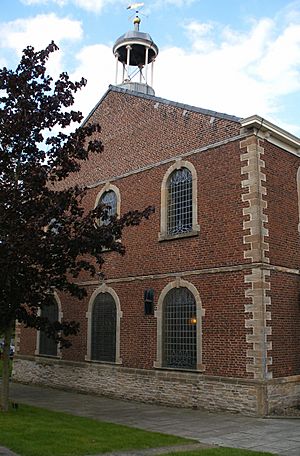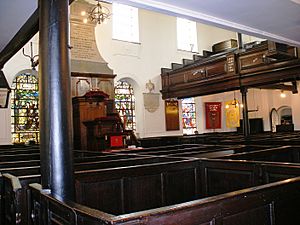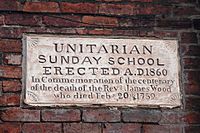Chowbent Chapel facts for kids
Chowbent Chapel is a special church building in Atherton, Greater Manchester, England. It's a place where people who follow the Unitarian faith worship. Built way back in 1721, it's the oldest church in Atherton. It's part of a bigger group called the General Assembly of Unitarian and Free Christian Churches. Because of its history and design, the chapel was given a special "Grade II*" listed status in 1966. This means it's a very important historical building.
Contents
A Look at Chowbent Chapel's History
The story of Chowbent Chapel began because of events in 1715. Before this chapel, there was an older church in Atherton. It was a small brick building called St. John the Baptist at Chowbent. This first church was built in 1645 on land owned by John Atherton. He supported people who had different religious ideas. This old church was used by a group called Presbyterians.
It was a long, low building having three windows and a porch on the south side and a large window in the east gable ...
The pulpit was of the old-fashioned Puritan three-tier style.
The Jacobite Uprising and Its Impact
In 1715, there was a big event called the 1715 Jacobite rising. This was when supporters of the "Old Pretender" (who wanted to be king) were marching. The minister of the old chapel, James Wood, and his church members were asked to help guard bridges near Preston. They successfully stopped the Pretender's supporters.
However, this upset Richard Atherton, who was about to inherit the land where the chapel stood. Richard Atherton strongly supported the king that the Jacobites were fighting against. So, in 1721, he made the church members leave the land. This is why they needed to build a new chapel, which became Chowbent Chapel.
The Chapel's Architecture and Design
The current Chowbent Chapel was built in 1721. The land for it was given by Nathan Mort. The building is made of rustic brick, laid in a pattern called Flemish bond. It has stone corners, known as quoins, and a decorative edge under the roof called an eaves cornice. The roof is made of slate.
Exterior Features of the Chapel
The sides of the chapel have three sections, and the back has four. All these sections have round-arched windows. On the roof, there's a small tower called a cupola that holds a single bell. In 1901, a two-story part was added to the south side. This new part has a triangular shape above the entrance, called a gable pediment. Inside this triangle, there's a round window, or oculus. Above the double doors, you can see a decorative window called a fanlight. There's also a sundial and a special plaque above that.
Inside Chowbent Chapel
A famous expert, Nikolaus Pevsner, said that Chowbent Chapel has "the best-preserved 18th-century church interior in South Lancashire." This means it looks very much like it did when it was first built. Inside, you'll find the original box pews, which are like small enclosed seating areas. There's also a tall, three-level pulpit on the north wall.
Galleries, which are like balconies, are on the east, south, and west sides. You can reach them by staircases with decorative railings called balusters. Six round oak columns support these galleries and continue up to hold the plaster ceiling. A strong oak door, covered in nails, separates the chapel from the vestry (a room for the minister). This door might be from the very first chapel built in 1645.
Other old items from the 1645 building include the communion table and two silver communion cups. These cups were given by Robert Mort in 1654. They are very old and special, but they are not usually kept at the chapel. Some of the colorful stained glass windows were made by a company called Shrigley and Hunt.
When the chapel was new, you could see the wooden beams and supports in the roof. The walls were painted white, and the windows had clear glass in a diamond pattern. An organ was added in 1806 to provide music, as before that, only singing was used. A new organ was installed in 1901 when the chapel was made bigger.
Community Life at the Chapel
Soon after the chapel opened, a schoolroom was started in the minister's house. This school was made bigger in 1860 and again in 1890. Before 1900, the chapel also opened a library at Chowbent School for everyone in the town. This library had 4,000 books! When Atherton's public library opened in 1905, all these books were given to it.
Notable Ministers of Chowbent Chapel
Over the years, several important ministers served at Chowbent Chapel. One was Harry Toulmin (1766–1823). He later moved to America and became the Secretary of State for Kentucky. Another was Thomas Walker Horsfield (1792–1837), who was a historian and wrote about different places.
See also
- List of churches in Greater Manchester
- Grade II* listed buildings in Greater Manchester
- Listed buildings in Atherton, Greater Manchester




